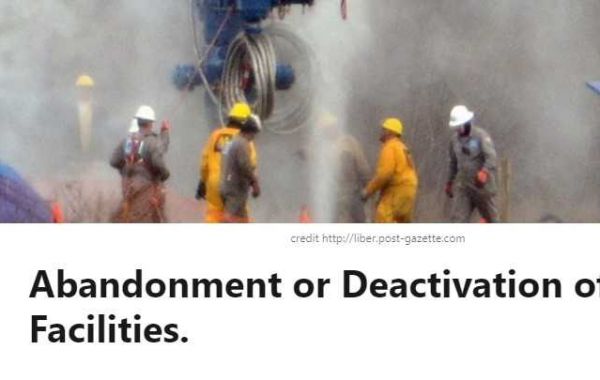With oil prices at the bottom (tonight oil is at $18.12) and many companies sending notices of "reduction in force" to valuable members of their team which they can no longer keep on payroll, it is often the safe abandonment, deactivation with integrity and risk management that gets missed. Don't let this critical step be sidelined as your best in the field are furloughed. Sure, upper management says, "let'm go", but at what cost? Are there punch lists that need to be completed? Are you certain that job was checked for quality and you have all the close out documentation?
full article TimesCall
Former Anadarko employees said that there were so few inspectors for Anadarko’s wells, that often inspectors only had five minutes to visually inspect a well and sniff for dangerous gases before driving to the next location.
The anonymous employees cited in the suit claim that the safety issues in Weld County were raised several times with top-tier executives at Anadarko, only to be ignored.
In March 2016, Anadarko laid off 20 to 30 percent of its staff in every division, which meant that staffing levels in Colorado fell to 1,000 by mid-2017 from a previous level of 1,500 employees.
According to two anonymous former employees, Anadarko then “‘ramped up’ its activity in Colorado. Indeed, Anadarko increased its count of well-drilling rigs in Colorado from one in August 2016 to five in November 2016. Yet Anadarko did not hire employees to do the additional work.”
Above: Detail of methane leak imagery from Firestone, CO.
As companies see inspection as a cost, not an area of profit, it is often inspection that is bid and paid at the lowest possible rate. Ultimately this has consequences, as in the case in Firestone, Colorado.
The COGCC announced the proposed fine last month to punishKerr McGee for the destruction of the Martinez home. The fine approved Monday is more than 10 times larger than the previous top penalty assessed by the agency against an oil and gas company — a $1.6 million Noble Energy fine in 2018.
COGCC Director Jeff Robbins last month explained that “the aggravating factor of death” boosted the fine amount. Erin Martinez chastised the industry in her statement to the commission.
“As an industry, it is critical that you are held responsible to properly maintain all and any equipment left in the ground,” she said. “The bottom line, had you done your job correctly, my husband, my children’s father, and my brother would be alive today. Had the flowline been properly abandoned from the beginning, then nothing that transpired after would have led to the explosion.”
Anadarko reached an undisclosed settlement agreement in 2018 with the families of victims and survivors.
The National Transportation Safety Board concluded last fall that the likely cause was a natural gas leak through a pipeline that had been cut during construction of the home two years earlier.
Fire investigators found a plastic pipe running from an Anadarko well near the house that had been cut when a tank battery was moved before the Oak Meadows subdivision was built five years ago. That pipeline leaked the gas from a point 6 feet from the southeast corner of the home.
Investigators said they found the gas valve at the Anadarko well in the “on” position.
So how as a responsible operator or contractor are you to abandon or deactivate your facility or pipeline?
There are standards and API has them.
API RP 51R Environmental Protection for Onshore Oil and Gas Production Operations and Leases
I would like to highlight this section, 8.9 of API RP 51R as it pertains to Firestone, CO.
c) Where appropriate, each outlet of any abandoned lines should be permanently sealed.
d) Operators should consider removing all crossing markers and other line markers.
e) Where appropriate, the location of abandoned lines should be identified on facility maps.
There are also standards for pipeline in the Federal CFR cited in this article's title.
(1) The preferred method to submit data on pipeline facilities abandoned after October 10, 2000 is to the National Pipeline Mapping System (NPMS) in accordance with the NPMS “Standards for Pipeline and Liquefied Natural Gas Operator Submissions.” To obtain a copy of the NPMS Standards, please refer to the NPMS homepage at http://www.npms.phmsa.dot.gov or contact the NPMS National Repository at 703-317-3073.
A digital data format is preferred, but hard copy submissions are acceptable if they comply with the NPMS Standards. In addition to the NPMS-required attributes, operators must submit the date of abandonment, diameter, method of abandonment, and certification that, to the best of the operator's knowledge, all of the reasonably available information requested was provided and, to the best of the operator's knowledge, the abandonment was completed in accordance with applicable laws. Refer to the NPMS Standards for details in preparing your data for submission. The NPMS Standards also include details of how to submit data. Alternatively, operators may submit reports by mail, fax or e-mail to the Office of Pipeline Safety, Pipeline and Hazardous Materials Safety Administration, U.S. Department of Transportation, Information Resources Manager, PHP-10, 1200 New Jersey Avenue, SE., Washington, DC 20590-0001; fax (202) 366-4566; e-mail
InformationResourcesManager@phmsa.
dot.gov.
The information in the report must contain all reasonably available information related to the facility, including information in the possession of a third party. The report must contain the location, size, date, method of abandonment, and a certification that the facility has been abandoned in accordance with all applicable laws.
Now lets get back to work safely . . . and keep oil and gas jobs in Colorado.











